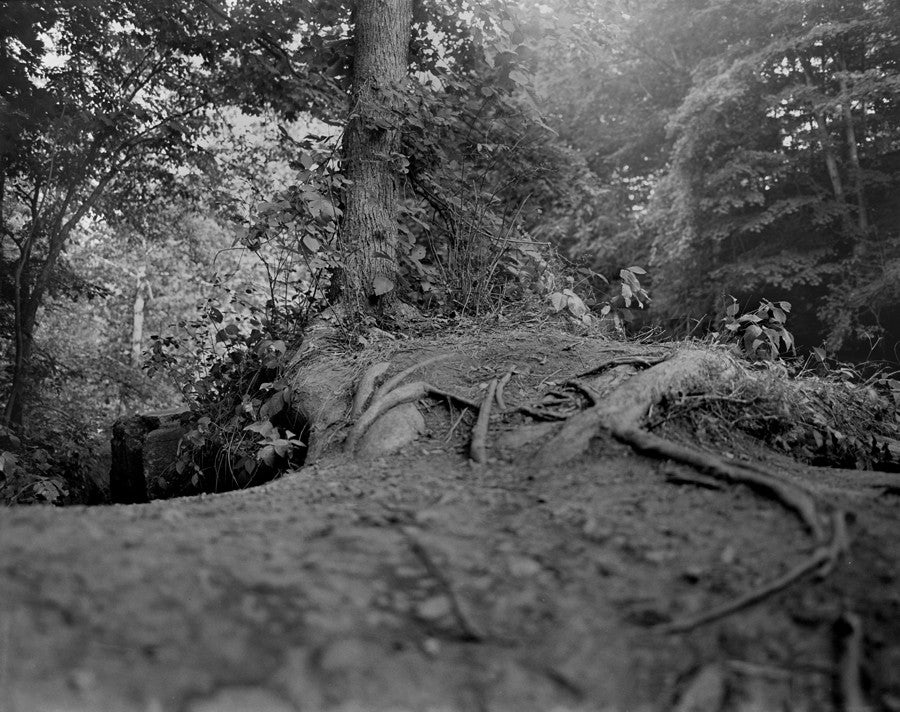The first time I saw Furlong by Raymond Meeks, it was on the walls of a trendy photo fair. At least four times I went back to his gallery booth to stare at the quiet beauty of it, to disappear in it, and to escape the multicolored screaming of the fair. Six simple wooden frames it was: each one containing a spread of slightly yellowed paper with one, two, or three black-and-white carbon pigment prints carefully arranged on it, depending on how the feeling guided the form. At the time of this writing, Furlong has also become an elegant artist book – the first in a series, handmade in a limited edition of only 20 copies – the kind of jewel that has gained Meeks his reputation as a tender craftsman.
Furlong is about a group of adolescents – boys in swimming trunks and girls wearing bikinis – experiencing an American summer near a boggy creek, surrounded by broad-leaved trees, rocks covered in moss, and chalkstone cliffs, from which they fearlessly drop themselves in the water. The stream is in walking distance of Meeks’s front door and there is a tall bridge crossing it; they jump from there as well. In Meeks’s images it looks like a hidden and mystical place, partly because of the light falling in from above or gliding through the trees, beautifully captured in his lens. It’s as if these kids first have to find a concealed path or make their way through some secret cave to reach this unknown paradise.
The teenagers are nameless. It’s all about the youth they represent, the freedom and the lightheartedness they and this careless summer symbolize. The grace with which their young bodies, frozen in thin air, for just one single moment become separate from the world. Everything is serene, the spirit is cool and time stands still – this is also suggested by titles such as Paralysis, Sometimes Even Now and Day That I Have Loved, the names that go with the pieces on the wall.
Yet you feel: this perfect moment will not last. At the end of each blissful summer’s day the sun must set, in the same way youthful innocence surely will evaporate with time. The youngsters throw themselves into a dark deepness of which we rarely see the bottom clearly, as if they fall blindly and in good faith into the murky pond of adulthood. With Furlong, Meeks has written a poetic fragment of a coming-of-age story, pregnant with nostalgia and deeply rooted in American pastoral culture.
“All we do with photographs is sense things,” writer and curator David Campany says. “And when we sense things what we are doing is a mix of recognition and wishing.” It’s not hard to see ourselves in the adolescents in Furlong. Who hasn’t been there – somewhere on a rock, your heart pounding in your chest, your mind blank, ready for the breathtaking leap? In that sense Furlong is instantly recognizable. Simultaneously the work recalls a longing, for days that were felt as undefiled, for the primitive of nature and the essence of things. It is within these wide, floating, poetic metaphors that the strength of Meeks’s work lies.
A time leap of eleven years it is from here, from Furlong, back to Sound of Summer Running, Meeks’s first monograph, published in 2004, that launched him into the art world after a career as a commercial photographer. Just about halfway the book we stumble upon two images of a group of bathers – youngsters and adults, boys and girls – plunging from a wooden dock into a lake. Next to that a delicate portrait of Meeks’s son Adam; he must be about eight. This is the heart of the summer, where the sun wraps the sweet days in a warm blanket, and the calm sensation of an everlasting glow predominates.
Bathed in pictorialism and its painterly light, the deep brown tainted images in Sound of Summer Running are shamelessly romantic. They tell a story of warmhearted and carefree family happiness in rural Montana. Meeks’s daughter Abbey, who he has been photographing since she was two, plays the leading part in the book with a natural flair, at once discovering her dreamlike environment, then lying in the grass, turned into herself. Next to a warm breeze, an undertone of quiet melancholy runs through the work, wherein the surrounding landscape plays a heavy part. If the black crows, who are prominently featured on the book’s cover and sporadically make an appearance inside, are ominous messengers, then it is mostly the dramatic, very atmospherical picture of the fallen tree in the creek that carries the prophecy of a broken ideal.
The family moves to Portland, a shift of environment in which Meeks sees a final effort to alter what feels like an inevitable course. Despite the will to keep the family intact, the gorge is too deep. In the following trilogy Carousel (2009), Amwell | Continuum (2010) and Who Will Stay (2010), tactile artists books weaving together images of the left behind landscape in Montana, of the empty house and of his children, Meeks digs himself a way to the very core of this loss. For him these books are exercises in redirecting emotional hardship toward an expression of beauty, allowing him to focus on gratitude, for the undeniable joy that once was, instead of anger, fear, or regret. At the same time it was a way of spending time in his studio and collaborating with his children, whose opinions and hands have always played a defining part in his books.
Fatherhood, a connection to place, the landscape, and the things in life we lose along the way: these are the reoccurring elements in Raymond Meeks’s work. With his two children out of the house and studying, he feels stuck in the past and the need to move forward. He sells most of his previous studio furnishings and equipment, throws away thousands of negatives, trades over half of his previous wardrobe and pares down his book collection from 1300 to about 200. He takes a restless jump forward, one as dizzying as the ones the kids take in Furlong, and moves to the East Coast. For what will become Erasure (2013) Meeks primarily photographs from his moving car, in which he drives around seemingly aimlessly. The people gliding along his car, mostly African-American, have an alienated and lost feeling about them. Meeks is not looking for any human contact; all familiarity is gone. A couple of years and another move later, a new sense of ardour is found. In Love With Drama (2015) shows intimate images of a woman and wide landscapes, full of fertile ground, and careless children playing free. If you want, you can hear a silent, cautious echo of Sound of Summer Running ringing through in the distance. But it is different, that much is sure. Nothing can ever be the same.
Back to Furlong. From high up the rocks in Catskill Creek, ready to take the exciting leap himself, Meeks all of a sudden gets thrown back to his own youth. “Standing near the forests edge,” he writes on his website, “all of my senses tune in to memory and recall a summer thirty years ago when there seemed an eternity at my feet. I did finally make the giant leap on what felt like the last day of this summer, arms windmilling wildly to keep my body from flailing sideways . . . The bruises on my arms and back put me in touch with each of my fifty-plus years.”
Sometimes, like here in Furlong, the circle between the present and the past closes in a fraction of a second: the time it takes to jump into the water. Meeks however notices different circles in time. Circles in which different moments, even if they lie years apart, manage to touch each other – most of the times unexpectedly. “Some circles in life are narrow, some are broad,” he once said in an interview. “Amwell” – from Amwell | Continuum – is the name of a street in Columbus, Ohio, where he lived the most formative, yet emotionally burdened, years of his youth. When his marriage started to fail, it felt like somehow a circle was completed. “I felt like it started on that street in Ohio, and it came full circle for me.” Meeks also incorporates these circular movements in his work, more specifically in the loose and open narratives he builds. By taking images from earlier books and letting them return in new ones, Meeks doesn’t only connect the present with the past, he also manages to create opportunities for shifting interpretations and the creating of new meaning over time.
Meeks’s work challenges us, at those moments in our lives where a cycle comes full circle, to look for the beauty in what remains. Because only in that beauty can we find the reasons to move forward once again. “My fear,” Robert Adams once said, “is that we in the art world are not consistently and ardently enough addressing that old traditional job of art: to reconcile us to life.” The openheartedness, the integrity, and the dignity with which Meeks continues to do this in his work, is hopeful.
A Dutch version of this text was published in the 2015 December issue of Belgian art magazine Oogst. This is a slightly altered version.

